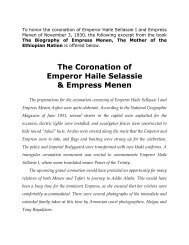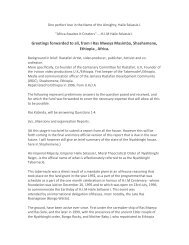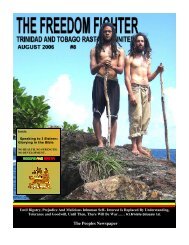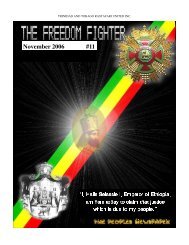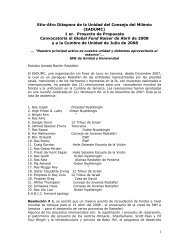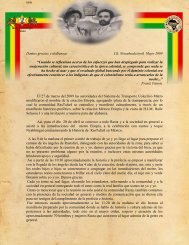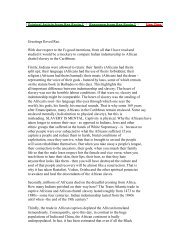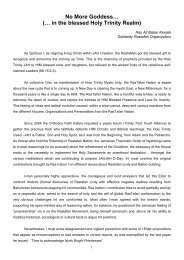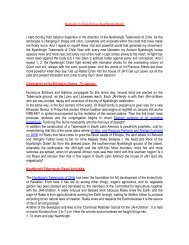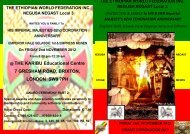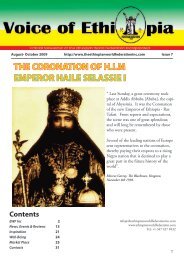DRAFT Universal Hair Exemption Letter TO: United ... - RasTa Ites
DRAFT Universal Hair Exemption Letter TO: United ... - RasTa Ites
DRAFT Universal Hair Exemption Letter TO: United ... - RasTa Ites
Create successful ePaper yourself
Turn your PDF publications into a flip-book with our unique Google optimized e-Paper software.
Caribbean identity and Afro-centric values that strengthened<br />
the impulse for African liberation on both sides of the<br />
Atlantic, while serving as a positive force for Africa globally."<br />
[Note: an integral and most visible part of the African<br />
identity is the wearing of locks ala various tribes in<br />
Ethiopia, Somalia, Kenya, etc]<br />
7. Rastafari leaders were among approximately 100 leaders from Faithbased<br />
Organisations (FBOs) across the Caribbean Community<br />
(CARICOM) that participated in Champions for Change II: Regional<br />
Conference of FBOs, in Georgetown, Guyana on November 22-23. 2005.<br />
8. Rastafari will be represented at the Global Dialogue of Faiths: Religion,<br />
the Slave Trade, and the case for African Reparations in Bridgetown,<br />
Barbados, August 27, 28, & 29, 2007<br />
II. Rastafari people around the world are known for their wearing of the<br />
Covenant of Locks.<br />
Many Elders and most brethren and sistren of the Rastafari faith refer to Biblical<br />
scripture such as Numbers 6:5 and Leviticus 19:17.<br />
"All the days of their Nazarite vow no razor shall come upon the head; until the time is complete for<br />
which they separate themselves to the Lord, they shall be Holy; they shall let the Locks of the head<br />
grow long." Numbers 6:5<br />
"You shall not round off the hair on your temples or mar the edges of your beard." Leviticus 19:27<br />
1. Beginning with field studies on the Rastafari movement in 1953 by<br />
Professor George Eaton Simpson of Oberlin College, Ohio, U.S.A. under<br />
the sponsorship of the Institute of Social and Economic Research,<br />
U.C.W.I., all subsequent literature and scholarship on Rastafari has<br />
repeated Simpson’s statement that:<br />
“From the earliest days, many Ras Tafari brethren had worn beards and let their<br />
hair grow, because of Ezekiel 5 and other Scriptures. . . . Numbers 6:I,ii, v<br />
provides the Biblical basis for this practice. And the Lord spake unto Moses,<br />
saying: ‘Speak unto the children of Israel and say unto them, When either man<br />
or woman shall separate themselves to vow the vow of a Nazarite, to separate<br />
themselves unto the Lord…all the days if the vow of the separation there shall no<br />
razor come upon his head: until the days be fulfilled in the which he separateth<br />
himself unto the Lord, he shall be holy and shall let the locks of the hair of his<br />
head grow.” According to informants, the men of Dreadlocks first began to<br />
appear in Kingston round about 1947.” ."<br />
2. Some Rastafari brethren wear their locks as part of an Ethiopian<br />
tradition of monasticism whose adherents are called “Bhatawi”. This<br />
tradition is pre-Biblical and is depicted on “Narmer’s Palette”, an ancient



